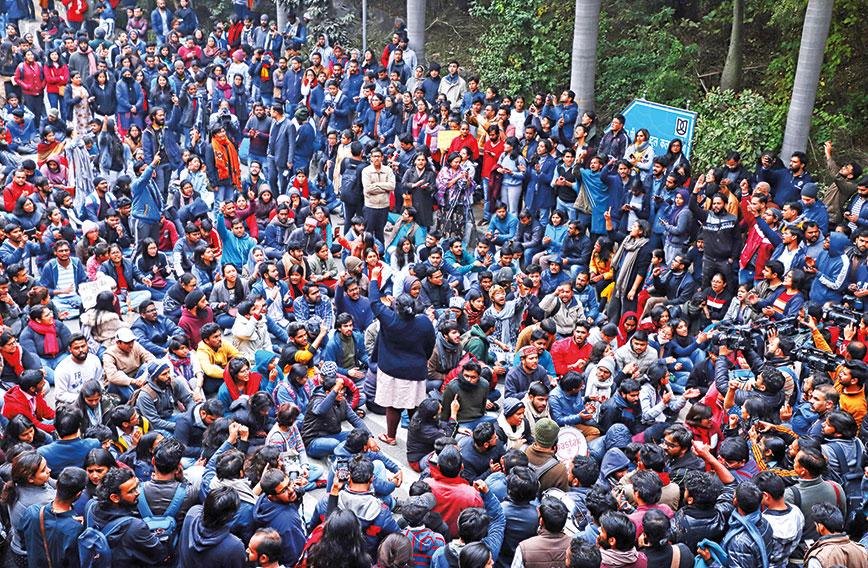
A sea of angry students protesting against the violence unleashed on the JNU campus | Shrey Gupta
Big campus upsurge: How students connect
Civil Society News, New Delhi
It was an old-style rampage that shook the campus of Jawaharlal Nehru University (JNU) on the evening of January 5. The lights mysteriously went off on cue. Marauders with their faces covered streamed in and attacked left-wing students and professors in their hostels and homes. The police stood by but didn’t intervene. Iron bars, hammers and large stones were used with lethal effect. The goal was to be swift and brutal and when the vandals left, it was as easily as they had entered.
But if the browbeating was staged to perfection, it also almost immediately ran into a barrage of outrage from quarters much beyond JNU. In a networked world it is difficult to keep even the most carefully scripted pogrom secret. Images of the attackers destroying property and assaulting people quickly went viral. Videos and pictures went onto television and into homes. More importantly, they got shared on campuses across India, galvanizing students in spontaneous protests on a scale not witnessed in the 70 years since Independence.
Most shocking of all was a clip of Aishe Ghosh, blood gushing from a head wound, appealing for help. Ghosh is the firebrand leader of the Jawaharlal Nehru University Students’ Union (JNUSU). She is also a small and frail MPhil scholar all of 25 years old with a straightforward face and startlingly honest eyes. To think that anyone should have hit her on her head with an iron rod and fractured her arm was beyond shocking.
To read Aishe Ghosh's interview with Civil Society, click here
In the days after the episode, as she courageously addressed press conferences along with other students and teachers, she became a rallying point for the young in particular and decent-minded Indians in general. In contrast, the JNU administration and the Modi government at the Centre came to be reviled for allowing such violence to happen in the heart of the capital.
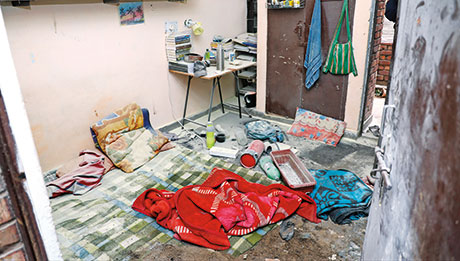 A JNU hostel room which was ransacked and left in shambles | Shrey Gupta
A JNU hostel room which was ransacked and left in shambles | Shrey Gupta
The theatre of action at JNU is currently about Left vs Right. Being unassailably in power at the Centre, the Bharatiya Janata Party (BJP) sees this as an opportunity to give a drubbing to a traditional leftist bastion known for its liberal atmosphere and socialist ideals. The BJP would like leftist unions to be replaced by its own Akhil Bharatiya Vidyarthi Parishad (ABVP).
Similarly, the government-appointed vice-chancellor, Mamidala Jagadesh Kumar, hasn’t exerted himself to be seen as being impartial. He is a respected professor of engineering, but he has made it clear that he is no admirer of JNU’s brand of liberalism.
The attack on JNU, however, has had quite the opposite effect. Instead of frightening leftists and liberals, it has brought out in large numbers young people unhappy with what they see as authoritarian policies and lack of prospects in a failing economy.
The immediate issue at JNU has been an increase in hostel fees. Other campuses, too, have been seething over rising fees and privatization. But the fee-hike worry has proved to be merely the tipping point. Students share a host of common concerns from the safety of women and their rights in educational institutions to the targeting of lower castes and Muslims, diminishing inclusion and the heavy-handedness of university administrations.
The rising tide of this collective unhappiness among the young has been directed against the Citizenship (Amendment) Act (CAA) passed by the Modi government and plans for a National Register of Citizens (NRC).
The JNU events followed a police crackdown at the Jamia Millia Islamia (JMI) in Delhi when students were protesting against the CAA and NRC. Jamia students were brutally beaten in their library and toilets. Then students from all over Delhi sat all night outside the police headquarters in protest.
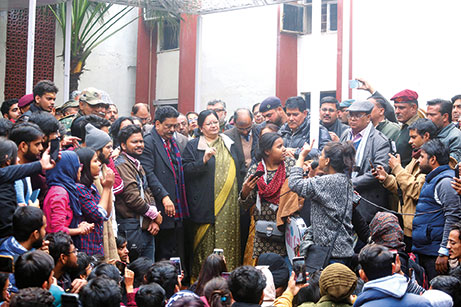 Jamia's vice-chancellor Najma Akhtar, promised students an FIR would be filed against Delhi Police | Ajit Krishna
Jamia's vice-chancellor Najma Akhtar, promised students an FIR would be filed against Delhi Police | Ajit Krishna
After the JNU episode, students came out in an even greater display of camaraderie on campuses as far apart as Tezpur and Patiala, hooking up through WhatsApp groups and coordinating protests. It has been a show of solidarity on a scale not witnessed before.
Some of the outpouring was predictable, an example being the politically volatile Jadavpur University in Kolkata. But students also came out on the most docile and apolitical of campuses such as the Indian Institute of Science (IISc) in Bengaluru, the Delhi School of Economics (DSE), St Stephen’s College, IIM Calcutta, IIM Ahmedabad, IIT Bombay, Tata Institute of Social Sciences (TISS) in Mumbai, National Institute of Design (NID) and so on.
The protests have been spontaneous and, though visibly supported by the leftist parties and the Congress, they have essentially been apolitical. Campus concerns have acquired traction of their own volition.
The main influence on campuses is wielded by the established unions such as the Students' Federation of India (SFI), affiliated to the Communist Party of India (Marxist); All India Students' Association (AISA), the student wing of the Communist Party of India Marxist-Leninist; National Students Union of India (NSUI) affiliated to the Congress, and the ABVP. On certain issues they agree. For instance, the ABVP and the leftist unions both opposed the fee hike.
But the recently witnessed nationwide protests have also come out of students banding together over time in loose and apolitical formations which provide collaborative energy of a different kind.
Pinjra Tod, The Collective and the Krantikari Yuva Sangathan (KYS) are examples of groupings that have brought young people together to jointly take up issues that concern campuses without being politically branded.
The Pinjra Tod movement began from Jamia Millia Islamia in 2015 when the administration issued a strict curfew for its female students. In October 2015, Pinjra Tod held a public hearing at Jantar Mantar and women from many Delhi colleges spoke about their experiences with their college administrations. It was the first platform to articulate such issues and Pinjra Tod grew as a women’s collective in Delhi institutions like JNU, Delhi University and Ambedkar University. Pinjra Tod has actively participated in campus protests since then — its members stood in solidarity in January 2016 when Rohith Vemula committed suicide and in February 2016, when Umar Khalid and Kanhaiya Kumar of JNU were labelled anti-national. With such involvements, Pinjra Tod has acquired a national character.
In 2015, The Collective was formed when some students in JNU felt the need to start a student organization independent of any political party. Students affiliated to political organizations often push their own agendas and toe a party line. “The idea of starting a student organization was to strengthen the revolutionary tradition of student politics. Students have been a very important constituent of any imagination of social change,” said Shreya Ghosh, a member of The Collective.
“The way the student movement is taking place, we realize there are some general demands across campuses. If there are no networks, it won’t work because JNU is not an island in itself,” explains Ghosh.
The Collective publishes a magazine, which circulates among students. Some students of Delhi University and Ambedkar University expressed a desire to be a part of the organization and in 2017-18, The Collective expanded to include the two universities.
 One of the many protests in Delhi | Shrey Gupta
One of the many protests in Delhi | Shrey Gupta
The KYS has been an active participant in protests since December 15. Not much is known about it, but it was launched in 2004 to address the issues of young working class people and students. It has a presence among students of the School of Open Learning in Delhi University and among residents of Anand Parbat, Seelampur and similar areas in Delhi.
“We want to link JNU’s struggle against the fee hike to the larger movement of making education equitable and accessible to marginalized sections of society,” says a KYS spokesman.
The values the young espouse point to the emergence of a different India. There is an abhorrence of caste and religious divides. Young women find their freedom from patriarchy in education and seek equal rights and access. It is felt that higher education should be affordable and equitably available so that everyone can benefit.
It is this sensibility among the young that has led to campuses erupting against the CAA and NRC and asking instead for genuinely competitive and forward-looking policies.
PRIVATIZATION, FEE HIKES
On October 28, the Inter Hall Administration of JNU passed the draft hostel manual, thereby increasing the hostel fees and doubling the cost of living on campus. Since then, students, led by JNUSU, have been protesting against the fee hike. The student body successfully boycotted the exams in December and asked for a return to the old fee structure.
“This is a government that has reduced its spending on education. Having denied jobs, having denied quality and access, now they want to physically destroy,” Jayati Ghosh, professor at the Centre for Economic Studies and Planning in JNU, said of the attack on January 5.
The proposed fee hike will directly impact 40 percent of students in JNU, whose annual family income is less than `1.5 lakh. The administration has said that it will offer concessions to students who come from Below Poverty Line (BPL) families. But students are not satisfied with this measure. They want a universal, inexpensive higher education system for everyone.
“If the normal slab for fees is high, what that does is make it a rule that education will not be affordable. It violates the principle of providing affordable education to all. The point is that, irrespective of your caste and class, you would have the same access to education,” said Shreya Ghosh who is a PhD scholar at JNU.
Giving scholarships and concessions is not a viable solution because the mechanism for scholarships is not without its problems. Fund cuts have led to fewer scholarships. About three years ago, the number of students who could benefit from the Government of India’s Post Matric Scholarship (GoI-PMS) was reduced.
“Most of the students, who I have the privilege of sharing the classroom with, would not be here if education is not subsidized,” said Pranati Haldia, a Master’s student at TISS, Guwahati.
At TISS Mumbai, the fees for GoI-PMS students are not released by the state government on time and the college administration scrutinizes the students for non-payment of fees.
Similarly, in Punjab, universities and colleges have a severe funds crunch. The Punjabi University in Patiala, one of the better-known universities in the state, has a deficit of `300 crore. The universities have failed to make new teacher recruitments since 1998. Thousands of students, mostly from high-income groups, go abroad every year for their studies.
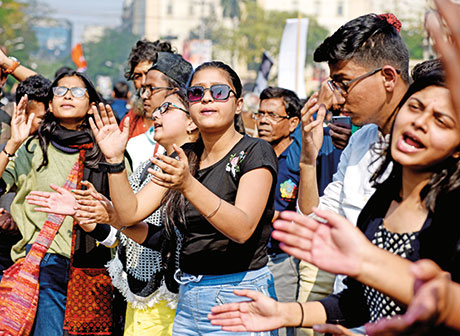 Girls demonstrate on a Kolkata street | Ankit Datta
Girls demonstrate on a Kolkata street | Ankit Datta
In Delhi University and Jadavpur University in Kolkata, students and teachers alike have been opposing the National Education Policy (NEP) because it lays the groundwork for privatization of education, and places the burden of funds on the university, instead of the government. These fee hikes can kill the social sciences, said Mounica Sreesai, a student at the Delhi School of Economics.
At Hyderabad Central University (HCU), the process is already underway. The university was given ‘Grade 1 autonomy’ which meant that it had to generate a larger percentage of the funds required on its own. This has led to fee hikes in the past and a fund cut for conferences. Three professional courses have been introduced in HCU, because higher fees can be charged for such courses.
Anupama Krishnan, a student at HCU, said that the administration could have rejected Grade 1 autonomy, but didn’t. “There are a large number of young people in India and it is the State’s responsibility to educate them. The government has the resources for it,” Krishnan said.
WOMEN'S CONCERNS
“Education can’t be a commodity. Historically, certain communities, such as women, Dalits and the poor, have been kept away from education. By privatizing education, we will go back to that,” said Maitreyi Jha of St Stephen’s College. For women on campuses, fund cuts can have serious consequences.
A PhD scholar at JNU said, “My father is in a government job. Without a public education system, I would not have been able to study.” She explained that families in India save money to spend on a girl’s wedding instead of spending it on her education. A subsidized education allows women to pursue higher education.
Women are also concerned about their safety on campuses. “JNU is extraordinary because it is one of the few places in Delhi where a woman could walk alone at night, and she would be safe,” says Jayati Ghosh. That sense of safety has diminished after January 5.
In Jamia Millia Islamia, female students were sexually harassed by the police but no student was willing to go on record about it, said Haldia, who was part of a fact-finding team at the university.
The Jamia administration asked female students to leave their hostels because it couldn’t ensure their safety. “This is the same administration which locks up women and restricts their mobility in the name of safety!” a coordinator from Pinjra Tod said.
“Anyway, it’s not easy for women to come to universities. Now parents are calling incessantly and asking their daughters to come back,” she said. Many have already left.
Since 2015, Pinjra Tod has been an important player in articulating women’s demands. Women on campuses want to be treated as adult citizens. They want to be free of curfew timings and from the sense of being watched. Any kind of political participation is seen in a very negative light, especially for women, the coordinator said.
TEACHERS' SUPPORT
The Jawaharlal Nehru University Teachers’ Association (JNUTA) has lent unconditional support to students in their protest against the fee hike. A professor, who also studied at JNU, said, “I have benefitted from a subsidized education. If I could get it, why can’t the others?”
 Teachers from colleges in Delhi joined the protests to express support for their students | Shrey Gupta
Teachers from colleges in Delhi joined the protests to express support for their students | Shrey Gupta
On January 9, when JNUSU and JNUTA called for a protest at Mandi House, demanding removal of the VC, many professors joined the protest. “We completely support our students in their protests,” Jayati Ghosh said. After the January 5 violence, many professors opened up their homes to students who feared going back to their hostel rooms.
At NID, IIM-C, IIM-A and IIT-B, professors have broken their silence over CAA, NRC and campus violence. The teachers’ association at HCU even released a statement in support of the anti-CAA protests.
“When we emailed our teachers about the boycott, their replies were very positive. Some of them even said, ‘We’re proud of you all’. We’re also learning how to organize ourselves and we consult our teachers. They tell us how to engage with people who may not agree with us,” said Mounica Sreesai of DSE.
On January 8, when students of colleges in Delhi gathered at Arts Faculty, 15-20 professors from St Stephen’s College marched along with their students. “The presence of teachers legitimizes the protest in many ways, because many students have not seen this culture of protest,” said Jha.
STRICT COLLEGE ADMINISTRATIONS
While teachers have been supportive of their students as they express solidarity with JNU, JMI and AMU, and voice their dissent, this has not been the case with college administrations. They have not welcomed this burst of political activity.
Jha, a student of St Stephen’s, mentioned that whenever there is a protest on campus, people from the administration videotape them to identify students. Rajvir Kaur from Punjab said, “Every time a protest is held, we are being kept under watch. The security guards make it a point to note down who all are taking part.”
At the National Institute of Design, the administration took down a poster put up by a student. At the Indian Institute of Management, in Kolkata, when students wanted to protest on campus, the administration tried negotiating with them, asking them to express their dissent in “other creative ways”. Finally, a silent protest was staged with permission. At the Indian Institute of Management in Ahmedabad, policemen in plainclothes dispersed a Preamble reading by students and teachers in the college grounds.
The heavyhandedness of college administrations is not new. Aakriti Suresh, an MPhil student at HCU, said that they are familiar with police intervention in campus life. Once, when they tried to screen an award-winning film on the Babri Masjid, the police detained them. At the English and Foreign Languages University in Hyderabad, students have been served show-cause notices for as little as organizing a street play.
But students are firm in their resolve. A student from NID said, “Students are scared of the administration taking action against them. But we realize there is strength in numbers.” A JNU student who was an eyewitness to the January 5 violence said that they are scared, but undaunted. “JNU has long stood for these principles. We will continue to fight.”
Students are fighting for the idea of an affordable public education and free university spaces. “The freedom to navigate spaces is the hallmark of any educational institution,” a student from IIM-A said. The freedom to express political opinions and to question is essential to the imagination of a free campus.
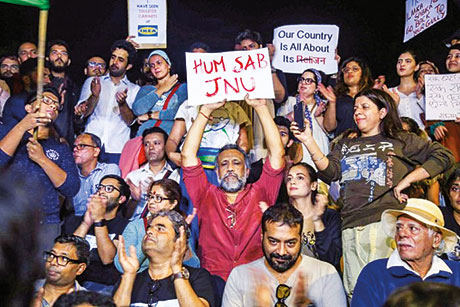 Protesters from the film industry at Carter Road in Mumbai
Protesters from the film industry at Carter Road in Mumbai
In Mumbai the stars speak up
Saibal Chatterjee, New Delhi
Three days ahead of the release of Meghna Gulzar’s Chhapaak, inspired by the life of an acid attack survivor, the film’s lead actor and producer, Deepika Padukone, visited the Jawaharlal Nehru University (JNU) campus to express solidarity with students who were brutally attacked by lathi-wielding and stone-pelting goons while Delhi Police personnel stood by and watched.
The Padmaavat and Bajirao Mastani star did not utter a word but was clicked greeting wounded JNUSU president Aishe Ghosh with folded hands. The picture spoke a thousand words. Padukone, who spent 10 minutes in JNU, joined a crowd of students and teachers standing behind CPI leader and former JNUSU president Kanhaiya Kumar as he addressed the gathering.
With that symbolic gesture of defiance, Padukone put the fate of her film on the line. The BJP’s foot soldiers instantly began baying for her blood on social media. Pro-government elements in cyberspace called for a boycott of Chhapaak and posted malicious reviews of the film on bookmyshow. But her supporters, including members of her own fraternity, were equally vehement in defending her.
Filmmaker Hansal Mehta told this writer: “It takes more than guts to take a stand the way Deepika did. As a popular movie star on whom so much rides, she would have been aware of the risk of losing a part of her audience. She went to JNU and stood by the assaulted students nonetheless and that’s what mattered.”
Writer-director Anurag Kashyap, a vocal critic of the Modi government, tweeted: “Let’s not forget she is also the producer of the film… the stakes are even higher. Mad respect.” Actress Sayani Gupta, too, lauded Padukone in no uncertain terms: “Thank you… for giving this movement a mainstream narrative. For using your position to choose the correct path.”
It wasn’t as if Padukone was the first from the Mumbai movie industry to lend support to the protests. Many Bollywood voices had already been heard loud and clear in favour of the growing agitation against the Citizenship (Amendment) Act (CAA) and celebrating the role of the students and women in propelling it. Many prominent actors and filmmakers threw their weight behind the battle to protect the secular core of the Constitution of India and to uphold the people’s inalienable right to hold peaceful protests against a decision of the government.
The likes of Kashyap, Anubhav Sinha and Swara Bhaskar, whose political leanings are unambiguous, stood their ground and fought “pitched battles” with an army of right-wing trolls on social media. Richa Chadda, Taapsee Pannu, Farhan Akhtar and Vishal Bhardwaj took part in protests and marches in Mumbai. Others, including mainstream stars such as Varun Dhawan, Alia Bhatt, Yami Gautam and Bhumi Pednekar articulated their alarm at the turn of events.
Many others pulled no punches in expressing their outrage at the brutality unleashed by the police (in Jamia Millia Islamia and Aligarh Muslim University) and masked assailants (in JNU). Actor Pulkit Samrat tweeted after the Jamia incident: “BARBARIC! UNDEMOCRATIC! UNSECULAR! (capitals his) That’s what we are turning into. Not the India I was born in!”
Actor Jim Sarbh was just as emphatic: “Stand up against divisive politics, against Islamophobia, against unconstitutional acts, and state sponsored violence. Power to the protesters, power to the students.”
Filmmaker Alankrita Shrivastava, too, minced no words after the uncalled-for police intrusion into Jamia: “Nothing can justify what has happened to the students. The broken legs, the lost eye, the assaults in the darkness, the barbaric beating up of the innocent, the vandalizing of a space of learning, the invasion of the student hostels. History will remember.”
Indeed, history will remember that many in Bollywood, an industry known to usually shy away from politics except when it suits its interests, stood up to be counted when it mattered. The Khans and the Kapoors, the real big guns of Mumbai cinema, have been at the receiving end of censure for choosing to keep quiet as the anti-CAA protests swirl all around us.
Early in Narendra Modi’s first term as prime minister, Shahrukh Khan had spoken about growing intolerance in India. In retaliation, his film Dilwale was targeted by an easy-to-offend tribe of BJP supporters. Aamir Khan, too, had flagged the issue of rising insecurity and fear. As a fallout, Snapdeal pulled out of an endorsement deal with him. Since then the two Khans have opted for silence in matters political.
Hansal Mehta suggests that we might be giving Bollywood too much credit for the protests that are being staged across the nation. “It is entirely a people’s movement, completely democratic. It has spread organically," says the director of Shahid and Aligarh.
For the nation at large, there is a lot at stake, says Mehta. “But beyond a point, we, as film industry people, do not have all that much at stake,” he adds. “The students spearheading the protests have put far more at risk — their entire future.”
Kolkata-based film director Sekhar Das, whose films usually deal with subaltern realities, says: “The protests are absolutely understandable. The government is telling us that we are not citizens unless we prove otherwise. It is high time people in power realize that majoritarianism does not work in a secular democracy.”
It is easy to see why screenwriter, lyricist and standup satirist Varun Grover’s poem, "Hum kaagaz nahi dikhayenge" (We will not show our papers) has resonated so widely, nowhere more so than in Kolkata. Not only has the musician duo of Mayukh and Mainak composed a tune for the lines, filmmaker Ronny Sen in collaboration with his associates has also produced a video of the Bangla version of the poem. A host of important Bengali film personalities ranging from veterans Dhritiman Chatterjee and Sabyasachi Chakraborty to Konkona Sen Sharma, Tillotama Shome and Swastika Mukherjee have participated in the video.
India’s entertainers aren’t shying away from making their voice count.
Comments
Currently there are no Comments. Be first to write a comment!



